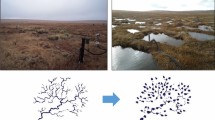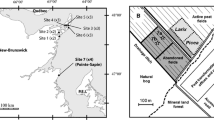Abstract
Artificial drainage networks established throughout peatlands during the peat extraction process often remain active following abandonment, maintaining a water table relatively far from the surface of the peat, and hindering the survival and reestablishment of Sphagnum mosses. As an initial restoration effort, the primary drainage network of an abandoned cutover peatland was blocked with a series of peat dams, consequently reducing the runoff efficiency and causing the site-average water table to rise by 32 cm. Higher water tables and a blocked drainage network resulted in increased runoff variability, dependent upon antecedent conditions (capacity to retain additional water on-site), and event-based precipitation dynamics. Evapotranspiration (ET) rates were 25% higher following rewetting (3.6 mm day−1) compared to pre-restoration ET rates of 2.7 mm day−1. Total storage changes were restricted following rewetting, as a factor of the reduced runoff losses limiting water table drawdown, thereby constraining peat compression and preventing undue drying of the unsaturated zone. An average surface level rebound of 3 cm was observed, increasing the mean hydraulic conductivity by an order of magnitude. Changes to the system hydrology following restoration efforts produced hydrological conditions more favourable for the recolonization of Sphagnum mosses.







Similar content being viewed by others
References
Bergeron M (1994) Peat. Natural Resources Canada, Ottawa
Canada E (2003) Climate Normals. Environment Canada
Dionne J-C (1977) La mer de Goldthwait au Québec. Géographie physique et Quaternaire 31:61–80
Eggelsmann RF (1976) Peat consumption under influence of climate, soil condition and utilization. p. 243–247. Proc. 5th Int. Peat Congr., Poznan, Poland
Girard M, Lavoie C, Thériault M (2002) The regeneration of a highly disturbed ecosystem: a mined peatland in Southern Québec. Ecosystems 5:274–288
Gleeson J, Zeller A, McLaughlin JW (2006) Peat as a fuel source in Ontario: a prelimnary literature review. Ontario Forest Research Institute. MNR, Sault Ste. Marie
Holden J (2005) Peatland hydrology and carbon release: why small-scale process matters. Philosophical Transactions of the Royal Society 363:2891–2913
Hvorslev MJ (1951) Time lag and soil permeability in groundwater observations. US Army Corps of Engineers, Vicksburg
Ingram HAP (1978) Soil layers in mires: function and terminology. Journal of Soil Science 29:224–227
Kennedy GW, Price JS (2004) Simulating soil water dynamics in a cutover bog. Water Resources Research 40
Kennedy GW, Price JS (2005) A conceptual model of volume-change controls on the hydrology of cutover peats. Journal of Hydrology 302:13–27
Keys D (1992) Canadian peat harvesting and the environment. Sustaining Wetlands Issues Paper. North American Wetlands Conservation Council, Ottawa
Kuhry P, Vitt DH (1996) Fossil carbon/nitrogen ratios as a measure of peat decomposition. Ecology 77:271–275
LaRose S, Price JS, Rochefort L (1997) Rewetting of a cutover peatland: hydrological assessment. Wetlands 17:416–423
Lavoie C, Grosvernier P, Girard M, Marcoux K (2003) Spontaneous revegetation of mined peatlands: a useful restoration tool? Wetlands Ecology and Management 11:97–107
Lavoie C, Rochefort L (1996) The natural revegetation of a harvested peatland in Southern Québec: a spatial and dendroecological analysis. Ecoscience 3:10
National Wetlands Working Group (1997) The Canadian wetland classification system—second edition. University of Waterloo, Waterloo
Price JS (1996) Hydrology and microclimate of a partly restored cutover bog, Quebec. Hydrological Processes 10:1263–1272
Price JS, Edwards TWD, Yi Y, Whittington P (2009) Physical and isotopic characterization of evaporation from Sphagnum moss. Journal of Hydrology doi:10.1016/j.jhydrol.2009.02.044
Price JS, Heathwaite AL, Baird AJ (2003) Hydrological processes in abandoned and restored peatlands: an overview of management approaches. Wetlands Ecology and Management 11:65–83
Price JS, Ketcheson SJ (2009) Water relations in cutover peatlands. In: Baird AJ et al (eds) Carbon cycling in Northern Peatlands, AGU Geophysical Monograph Series 184. p. 277–287
Price JS, Maloney DA (1994) Hydrology of a patterned bog-fen complex in southeastern Labrador, Canada. Nordic Hydrology 25:313–330
Price JS, Schlotzhauer SM (1999) Importance of shrinkage and compression in determining water storage changes in peat: the case of a mined peatland. Hydrological Processes 13:2591–2601
Price JS, Whitehead GS (2001) Developing hydrologic thresholds for Sphagnum reconolization on an abandoned cutover bog. Wetlands 21:32–40
Priestley CHB, Taylor RJ (1972) On the assessment of surface heat flux and evaporation using large-scale parameters. Monthly Weather Review 100:81–92
Read DJ, Leake JR, Perez-Moreno J (2004) Mycorrhizal fungi as drivers of ecosystem processes in heathland and boreal forest biomes. Canadian Journal of Botany 82:1243–1263
Rochefort L, Quinty F, Campeau S et al (2003) North American approach to the restoration of Sphagnum dominated peatlands. Wetlands Ecology and Management 11:3–20
Roul I (2004) Restoration strategies for block-cut peatlands: a hydrological and plant community analysis. M.Sc., Universite Laval
Schlotzhauer SM, Price JS (1999) Soil water flow dynamics in a managed cutover peat field, Quebec: field and laboratory investigations. Water Resources Research 35:3675–3683
Schothorst CJ (1977) Subsidence of low moor peat soil in the western Netherlands. Geoderma 17:265–291
Shantz MA, Price JS (2006a) Characterization of surface storage and runoff patterns following peatland restoration, Quebec, Canada. Hydrological Processes 30:3799–3814
Shantz MA, Price JS (2006b) Hydrological changes following restoration of the Bois-des-Bel Peatland, Québec, 1999–2002. Journal of Hydrology 331:543–553
Spieksma JFM (1999) Changes in the discharge pattern of a cutover raised bog during rewetting. Hydrological Processes 13:1233–1246
Tarnocai C (2006) The effect of climate change on carbon in Canadian peatlands. Global and Planetary Change 53:222–232
Van Seters TE, Price JS (2001) The impact of peat harvesting and natural regeneration on the water balance of an abandoned cutover bog, Quebec. Hydrological Processes 15:233–248
Van Seters TE, Price JS (2002) Towards a conceptual model of hydrological change on an abandoned cutover bog, Quebec. Hydrological Processes 16:1965–1981
Acknowledgments
Financial support for this research was provided by the National Science and Engineering Research Council (NSERC) through the Industrial Research Chair (Rochefort) and Discovery Grant (Price) programs. We thank Jacques Gagnon from Premier Tech for his efforts in coordinating the site rewetting. We are also grateful for the assistance provided in the field and lab by Nathalie Brunet, Sean Bryant, Mike Christie, Antonio DiFebo, Dave Fox, Janine Gilbert, Joseph Lance and Peter Whittington, as well as for assistance with GIS from Scott MacFarlane.
Author information
Authors and Affiliations
Corresponding author
Rights and permissions
About this article
Cite this article
Ketcheson, S.J., Price, J.S. The Impact of Peatland Restoration on the Site Hydrology of an Abandoned Block-Cut Bog. Wetlands 31, 1263–1274 (2011). https://doi.org/10.1007/s13157-011-0241-0
Received:
Accepted:
Published:
Issue Date:
DOI: https://doi.org/10.1007/s13157-011-0241-0




